When 17-year-old John wiped out on a downhill bike trail, he didn’t just lose control of his wheels he lost weeks of mobility, routine, and confidence. What began as a fractured collarbone turned into a life pause, filled with missed soccer games, mounting schoolwork, and the unfamiliar challenge of relying on others. Yet, what followed wasn’t just recovery! It was a journey. This is the story of how John turned a crash into a comeback, not just through rest, but with the powerful synergy of functional medicine and chiropractic care.

John’s initial treatment followed the standard orthopedic protocol immobilization, painkillers, and instructions to “take it easy.” But after four weeks, the pain lingered, his range of motion was poor, and sleep was still disrupted. “I felt stuck,” John recalled. “Like my body had healed on paper, but in real life, I was still fragile.”
That’s where a deeper, integrative recovery plan came in.
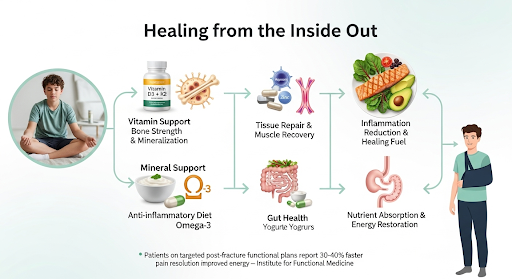
Unlike conventional care, functional medicine doesn’t just focus on the injury site, it examines the entire ecosystem of the body. For John, a personalized healing plan was built to support bone remodeling, reduce inflammation, and restore overall energy.
Key interventions included:
According to the Institute for Functional Medicine, patients on targeted post-fracture plans often report 30–40% faster pain resolution and improved energy levels compared to those on standard diets alone.
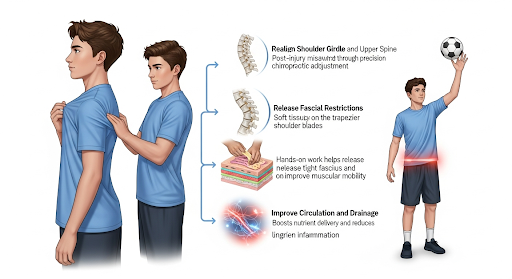
Once the bone was stable, chiropractic care stepped in to restore balance. Months of guarding the injured side had created tension, misalignment, and muscle imbalances. Chiropractic adjustments and soft tissue work helped:
A 2021 study in the Journal of Manipulative and Physiological Therapeutics found that patients who received post-fracture chiropractic care regained mobility 25% faster than those who relied solely on physical therapy.https://www.jmptonline.org/issue/S0161-4754%2822%29X0002
Dr. Sara Levinson, a board-certified chiropractor, notes, “When joints are properly aligned, healing accelerates. Nerve signaling improves, inflammation drops, and the body regains functional movement that’s critical after an injury.”
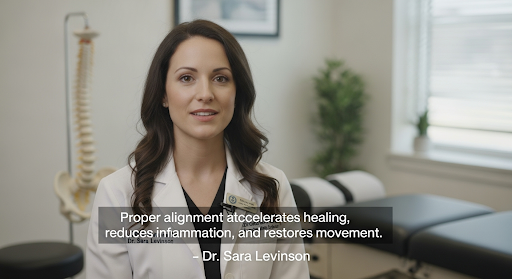
Within two months of his new regimen, John was not only pain-free. He was back on the field. His flexibility had improved, his posture was stronger, and he reported better focus and mood than before the accident.
The final part of John’s care plan included:
According to a 2022 meta-analysis in BMC Musculoskeletal Disorders, multimodal recovery approaches like this lead to fewer reinjuries, better long-term musculoskeletal health, and greater patient satisfaction.https://d-nb.info/1259328716/34
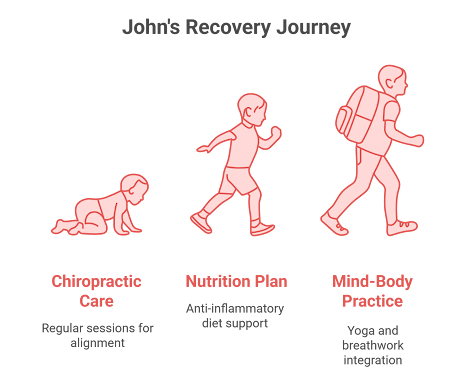
John’s story isn’t rare, it’s just rarely told. Too often, fracture care ends with the cast removal. But true recovery means rebuilding the whole person, not just the bone.
Functional medicine provides biochemical support for regeneration. Chiropractic care restores the physical harmony needed for movement. Together, they create a blueprint for deeper healing, one that isn’t just about going back to “normal,” but moving forward stronger.
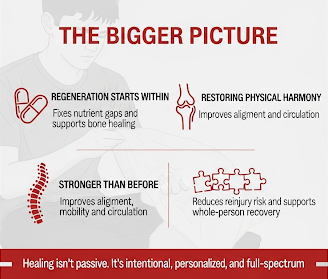
Fracture recovery isn’t just about waiting, it’s about choosing the right path forward. Whether you’re a teen like John, an athlete, or simply aiming to regain your daily rhythm, a functional and chiropractic approach offers a complete reset. True healing means reclaiming your strength, confidence, and peace of mind, not just mending a bone.
Still feeling “off” after your fracture healed? Don’t ignore the signals. Find a care team that blends chiropractic care with functional medicine. It’s time to heal smarter, not just faster.
Yes, once your bone is medically cleared for movement, chiropractic adjustments are tailored to promote mobility, alignment, and healing, without stressing the fracture site.
Functional medicine addresses nutrient deficiencies, inflammation, and hormonal imbalances that may slow down bone repair or increase reinjury risk.
Typically after the fracture has healed or stabilized. Your chiropractor will assess readiness and customize your treatment plan accordingly.
Calcium, Vitamin D, magnesium, Vitamin K2, and protein are critical for bone remodeling and repair.
Yes. Gentle mobilization and soft tissue work help break down adhesions and improve range of motion post-injury.
Integrative care reduces reinjury risk and improves biomechanics, which may reduce the likelihood of chronic issues or surgical intervention later.
The number of sessions depends on your injury, age, and overall health. Most people benefit from weekly chiropractic visits for 6 to 12 weeks, with frequency reducing as healing progresses. Your provider will assess recovery milestones and adjust your plan to ensure optimal mobility, alignment, and long-term function.
Yes, combining chiropractic care with physical therapy is often ideal. While physical therapy rebuilds strength and coordination, chiropractic ensures proper spinal and joint alignment. This dual approach helps prevent compensation patterns, accelerates recovery, and enhances long-term mobility, especially after fractures involving hips, shoulders, or lower extremities.
If you still feel stiffness, limited range of motion, lingering pain, or weakness after your bone has healed, it may indicate unresolved dysfunction. Other signs include imbalance, poor posture, or fatigue during simple movements. These symptoms suggest the body needs more targeted care to restore full function and biomechanics.
Many insurance plans now offer partial or full coverage for chiropractic and functional care, especially when medically recommended. However, coverage varies by provider and policy. It’s best to contact your insurance company or ask the clinic staff to help you verify your benefits before starting your recovery program.

